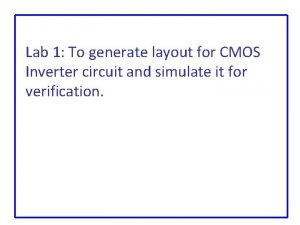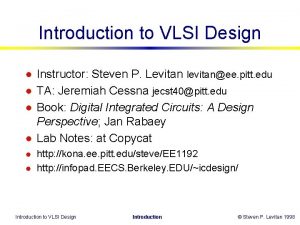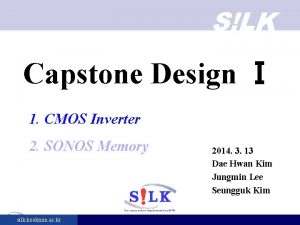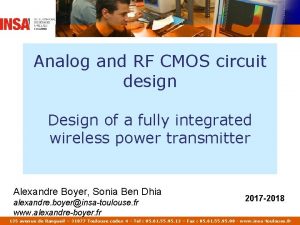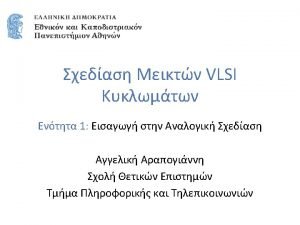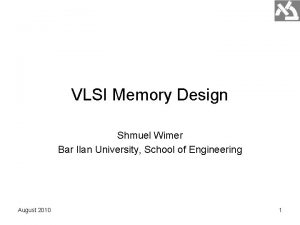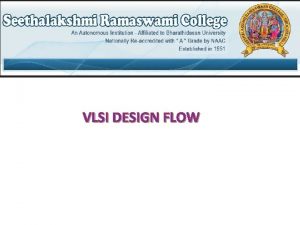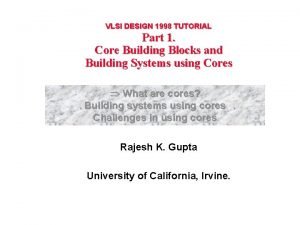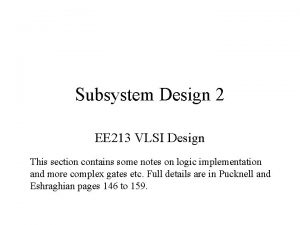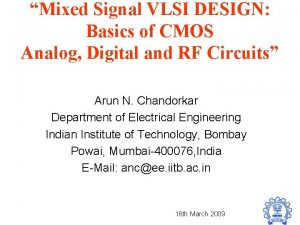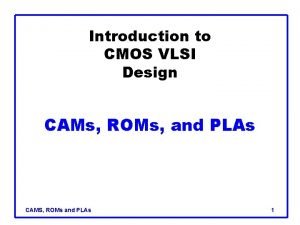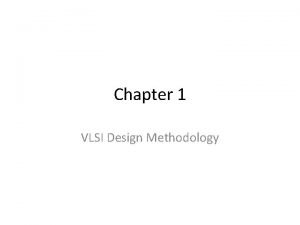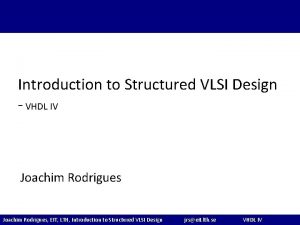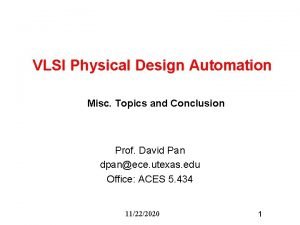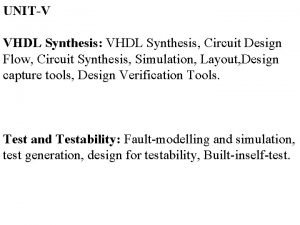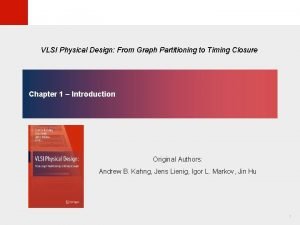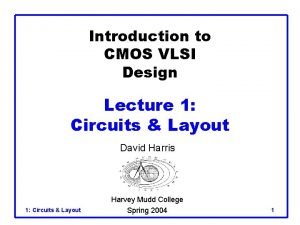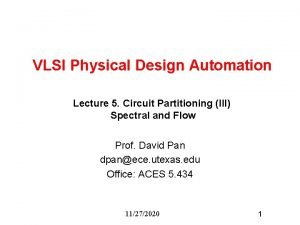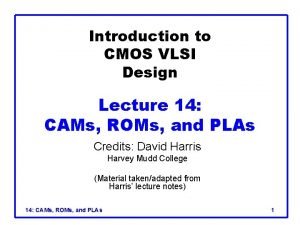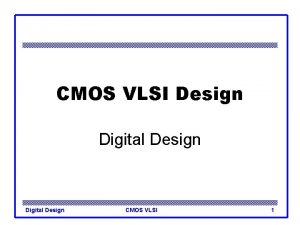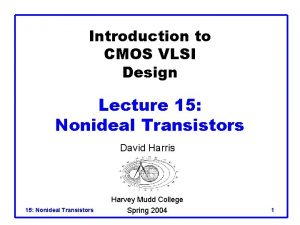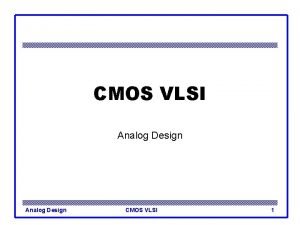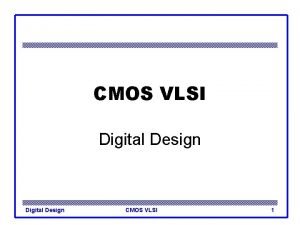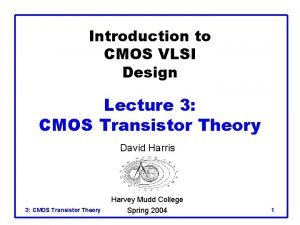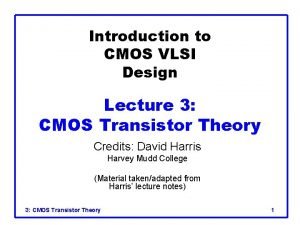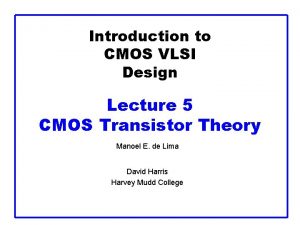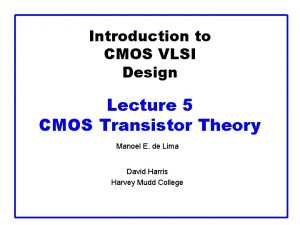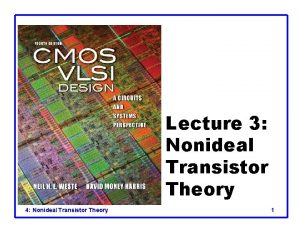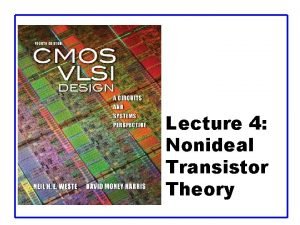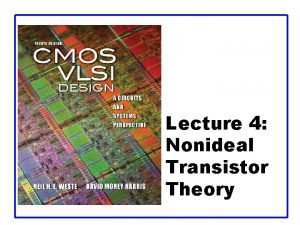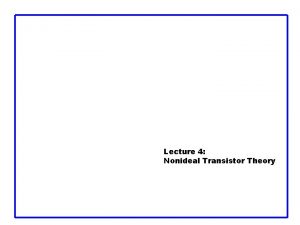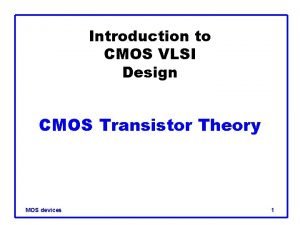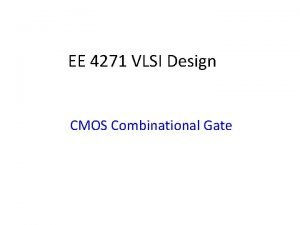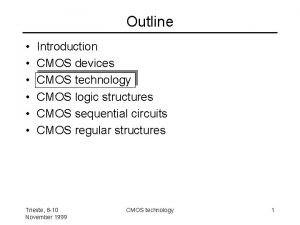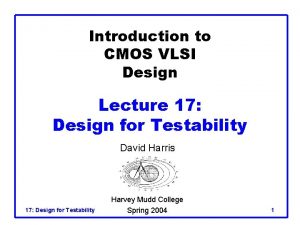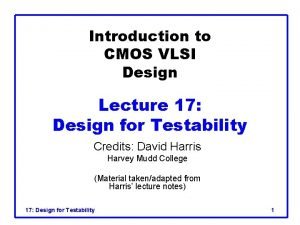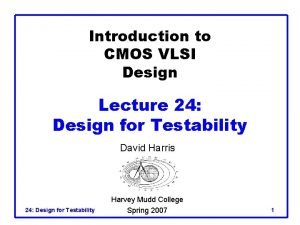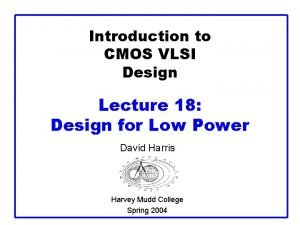Introduction to CMOS VLSI Design Lecture 15 Nonideal






























- Slides: 30

Introduction to CMOS VLSI Design Lecture 15: Nonideal Transistors David Harris 15: Nonideal Transistors Harvey Mudd College Spring 2004 1

Outline q Transistor I-V Review q Nonideal Transistor Behavior – Velocity Saturation – Channel Length Modulation – Body Effect – Leakage – Temperature Sensitivity q Process and Environmental Variations – Process Corners 15: Nonideal Transistors CMOS VLSI Design 2

Ideal Transistor I-V q Shockley 1 st order transistor models 15: Nonideal Transistors CMOS VLSI Design 3

Ideal n. MOS I-V Plot q 180 nm TSMC process q Ideal Models – b = 155(W/L) m. A/V 2 – Vt = 0. 4 V – VDD = 1. 8 V 15: Nonideal Transistors CMOS VLSI Design 4

Simulated n. MOS I-V Plot q 180 nm TSMC process q BSIM 3 v 3 SPICE models q What differs? 15: Nonideal Transistors CMOS VLSI Design 5

Simulated n. MOS I-V Plot q 180 nm TSMC process q BSIM 3 v 3 SPICE models q What differs? – Less ON current – No square law – Current increases in saturation 15: Nonideal Transistors CMOS VLSI Design 6

Velocity Saturation q We assumed carrier velocity is proportional to E-field – v = m. Elat = m. Vds/L q At high fields, this ceases to be true – Carriers scatter off atoms – Velocity reaches vsat • Electrons: 6 -10 x 106 cm/s • Holes: 4 -8 x 106 cm/s – Better model 15: Nonideal Transistors CMOS VLSI Design 7

Vel Sat I-V Effects q Ideal transistor ON current increases with VDD 2 q Velocity-saturated ON current increases with VDD q Real transistors are partially velocity saturated – Approximate with a-power law model – Ids VDDa – 1 < a < 2 determined empirically 15: Nonideal Transistors CMOS VLSI Design 8

a-Power Model 15: Nonideal Transistors CMOS VLSI Design 9

Channel Length Modulation q Reverse-biased p-n junctions form a depletion region – Region between n and p with no carriers – Width of depletion Ld region grows with reverse bias – Leff = L – Ld q Shorter Leff gives more current – Ids increases with Vds – Even in saturation 15: Nonideal Transistors CMOS VLSI Design 10

Chan Length Mod I-V q l = channel length modulation coefficient – not feature size – Empirically fit to I-V characteristics 15: Nonideal Transistors CMOS VLSI Design 11

Body Effect q Vt: gate voltage necessary to invert channel q Increases if source voltage increases because source is connected to the channel q Increase in Vt with Vs is called the body effect 15: Nonideal Transistors CMOS VLSI Design 12

Body Effect Model q fs = surface potential at threshold – Depends on doping level NA – And intrinsic carrier concentration ni q g = body effect coefficient 15: Nonideal Transistors CMOS VLSI Design 13

OFF Transistor Behavior q What about current in cutoff? q Simulated results q What differs? – Current doesn’t go to 0 in cutoff 15: Nonideal Transistors CMOS VLSI Design 14

Leakage Sources q Subthreshold conduction – Transistors can’t abruptly turn ON or OFF q Junction leakage – Reverse-biased PN junction diode current q Gate leakage – Tunneling through ultrathin gate dielectric q Subthreshold leakage is the biggest source in modern transistors 15: Nonideal Transistors CMOS VLSI Design 15

Subthreshold Leakage q Subthreshold leakage exponential with Vgs q n is process dependent, typically 1. 4 -1. 5 15: Nonideal Transistors CMOS VLSI Design 16

DIBL q Drain-Induced Barrier Lowering – Drain voltage also affect Vt – High drain voltage causes subthreshold leakage to ____. 15: Nonideal Transistors CMOS VLSI Design 17

DIBL q Drain-Induced Barrier Lowering – Drain voltage also affect Vt – High drain voltage causes subthreshold leakage to increase. 15: Nonideal Transistors CMOS VLSI Design 18

Junction Leakage q Reverse-biased p-n junctions have some leakage q Is depends on doping levels – And area and perimeter of diffusion regions – Typically < 1 f. A/mm 2 15: Nonideal Transistors CMOS VLSI Design 19

Gate Leakage q Carriers may tunnel thorough very thin gate oxides q Predicted tunneling current (from [Song 01]) q Negligible for older processes q May soon be critically important 15: Nonideal Transistors CMOS VLSI Design 20

Temperature Sensitivity q Increasing temperature – Reduces mobility – Reduces Vt q ION ______ with temperature q IOFF ______ with temperature 15: Nonideal Transistors CMOS VLSI Design 21

Temperature Sensitivity q Increasing temperature – Reduces mobility – Reduces Vt q ION decreases with temperature q IOFF increases with temperature 15: Nonideal Transistors CMOS VLSI Design 22

So What? q So what if transistors are not ideal? – They still behave like switches. q But these effects matter for… – Supply voltage choice – Logical effort – Quiescent power consumption – Pass transistors – Temperature of operation 15: Nonideal Transistors CMOS VLSI Design 23

Parameter Variation q Transistors have uncertainty in parameters – Process: Leff, Vt, tox of n. MOS and p. MOS – Vary around typical (T) values q Fast (F) – Leff: ______ – Vt: ______ – tox: ______ q Slow (S): opposite q Not all parameters are independent for n. MOS and p. MOS 15: Nonideal Transistors CMOS VLSI Design 24

Parameter Variation q Transistors have uncertainty in parameters – Process: Leff, Vt, tox of n. MOS and p. MOS – Vary around typical (T) values q Fast (F) – Leff: short – Vt: low – tox: thin q Slow (S): opposite q Not all parameters are independent for n. MOS and p. MOS 15: Nonideal Transistors CMOS VLSI Design 25

Environmental Variation q VDD and T also vary in time and space q Fast: – VDD: ____ – T: ____ Corner Voltage Temperature 1. 8 70 C F T S 15: Nonideal Transistors CMOS VLSI Design 26

Environmental Variation q VDD and T also vary in time and space q Fast: – VDD: high – T: low Corner Voltage Temperature F 1. 98 0 C T 1. 8 70 C S 1. 62 125 C 15: Nonideal Transistors CMOS VLSI Design 27

Process Corners q Process corners describe worst case variations – If a design works in all corners, it will probably work for any variation. q Describe corner with four letters (T, F, S) – n. MOS speed – p. MOS speed – Voltage – Temperature 15: Nonideal Transistors CMOS VLSI Design 28

Important Corners q Some critical simulation corners include Purpose n. MOS p. MOS VDD Temp Cycle time Power Subthrehold leakage Pseudo-n. MOS 15: Nonideal Transistors CMOS VLSI Design 29

Important Corners q Some critical simulation corners include Purpose n. MOS p. MOS VDD Temp Cycle time S S Power F F Subthrehold leakage F F F S Pseudo-n. MOS S F ? ? 15: Nonideal Transistors CMOS VLSI Design 30
 Cmos vlsi design lecture notes
Cmos vlsi design lecture notes Cmos layout design
Cmos layout design Layout inverter
Layout inverter Introduction to vlsi design
Introduction to vlsi design 01:640:244 lecture notes - lecture 15: plat, idah, farad
01:640:244 lecture notes - lecture 15: plat, idah, farad Inverter cross section
Inverter cross section Complex cmos logic gates
Complex cmos logic gates Device modeling for analog and rf cmos circuit design
Device modeling for analog and rf cmos circuit design Analog and digital difference
Analog and digital difference Memory design in vlsi
Memory design in vlsi Vlsi flow design
Vlsi flow design Biucache
Biucache Subsystem design in vlsi notes
Subsystem design in vlsi notes Mixed signal vlsi design
Mixed signal vlsi design Rom
Rom Intro to vlsi
Intro to vlsi Vlsi y chart
Vlsi y chart In which method regularity is used to reduce complexity
In which method regularity is used to reduce complexity Ad hoc testable design techniques
Ad hoc testable design techniques Structured vlsi design
Structured vlsi design Vlsi physical design automation
Vlsi physical design automation Vlsi design styles
Vlsi design styles Design flow
Design flow Vlsi design flow
Vlsi design flow Conduction complement rule
Conduction complement rule Design partitioning in vlsi
Design partitioning in vlsi Rom design in vlsi
Rom design in vlsi Introduction to biochemistry lecture notes
Introduction to biochemistry lecture notes Introduction to psychology lecture
Introduction to psychology lecture Introduction to algorithms lecture notes
Introduction to algorithms lecture notes Reinforcement lap lengths eurocodes
Reinforcement lap lengths eurocodes


